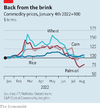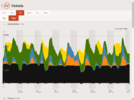- Joined
- 20 July 2021
- Posts
- 11,851
- Reactions
- 16,520
that would depend on if Europe also builds the facilities to accept delivery ( in the required volumes ) and transport it to regional customers .. at the current rate of decisions that would be a snowflake's change in an erupting volcano .
i have heard some interesting estimates .. but THEN we have the saga of the Siemens turbine to show us the NEW German efficiency ( which is still the manufacturing heart of the EU )
my bet is to consider investing in washcloths






